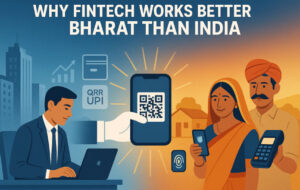Driving trust, access, and financial dignity beyond urban India.
Over the past decade, India has emerged as one of the world’s most vibrant fintech ecosystems. From UPI becoming a global case study to startups transforming how we pay, borrow, and save, the fintech wave is unstoppable. Yet, within this narrative of digital triumph, a dichotomy exists – fintech is a ‘nice-to-have’ for urban India, but a ‘need-to-have’ for Bharat.
In metros and Tier 1 cities, banking infrastructure is already well-established. Most people have access to bank branches and ATMs and possess proper documentation (PAN, Aadhaar etc). Being net savvy, they are also familiar with net banking, digital wallets, and can easily avail online financial services. For this segment, fintech offers enhanced convenience, a mobile-first experience, and streamlines tasks such as splitting payments, tracking expenses, or securing a loan with fewer clicks. It elevates an already functional system, making life a little easier, but not fundamentally changing access. This dynamic is not unique to India; in developed markets like the USA, neobanks like Revolut primarily serve urban, tech-savvy users, offering a superior user experience and lower fees as alternatives to traditional banks, rather than addressing fundamental access gaps.

However, the true revolutionary impact of fintech unfolds in Bharat – the vast expanse of India beyond the metros. Here, fintech transcends mere convenience; it becomes the essential infrastructure. In Tier 2, 3 towns and rural areas, traditional banking infrastructure is erratic, ATMs are far & few, and bank visits can entail long, arduous journeys. Many users in these regions are new to formal finance, let alone complex digital banking, and often lack the stable credit histories or formal documentation banks typically require. This is precisely where fintech steps in, not as a luxury, but as a vital bridge. Through assisted financial inclusion via banking correspondents and vernacular mobile apps, fintech platforms enable millions to open accounts, deposit and withdraw money, manage financial services, and access government benefits, bringing them into the formal economy for the very first time. This mirrors the success of companies like Brazil’s NuBank, which started by targeting underserved populations with simple, accessible digital banking, eventually growing into a massive financial institution by addressing unmet needs among a previously excluded demographic.
Furthermore, solutions like Buy Now Pay Later (BNPL) and unsecured instant loans, which leverage alternate data for risk assessment, are unlocking credit for the “credit-invisible” – small business owners, gig workers, and farmers who would otherwise be shut out by traditional banking hurdles. Beyond mere transactions, fintech in Bharat is fostering an ecosystem of digital literacy and empowerment. By simplifying complex financial concepts through intuitive interfaces and local language support, these platforms are educating users, building trust, and preparing them for broader participation in the digital economy. This goes beyond just providing a service; it’s about building foundational capabilities for future economic growth at the grassroots level.
In parallel, fintech is also playing a crucial role in streamlining government welfare disbursements through Direct Benefit Transfer (DBT) mechanisms. Whether it’s MGNREGA wages, LPG subsidies, or pension payouts, Aadhaar-enabled payment systems (AePS) and digital banking infrastructure have enabled the government to deliver benefits directly to beneficiaries’ accounts, reducing leakage and eliminating middlemen. For millions of rural Indians, this reliable and transparent access to government support via fintech platforms has been a game-changer, sometimes even their first real interaction with the formal financial system.
While the role of fintech in empowering Bharat is undeniably powerful, this immense reach also demands strict compliance and vigilance. The RBI’s regulatory role becomes paramount as fintech companies scale faster than traditional banks. Ensuring robust data security, responsible lending practices, transparent disclosures, and efficient customer grievance redressal are non-negotiable foundations for a healthy ecosystem.
Ultimately, the real fintech story in India isn’t just about making life easier for the urban elite; it’s about making life possible for millions in rural and semi-urban areas. For a small-town shopkeeper making their first digital transaction or a farmer securing a collateral-free loan via a mobile app, fintech isn’t just about financial convenience; it’s about financial dignity.
India doesn’t have one fintech revolution – it has two. And the one that truly matters is happening in Bharat. And as the next decade unfolds, Bharat won’t just be fintech’s largest market, it will be its most meaningful proving ground. The real winners will be those who don’t just digitise processes or make fancy Apps, but truly solve problems that matter.



